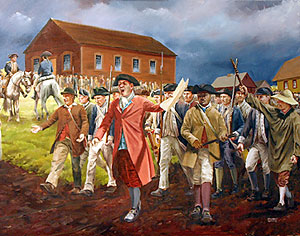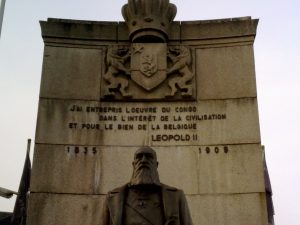
The Articles of Confederation were created by the United States in an act to form a written constitution in 1777. Ratified in 1781, the Articles seemed a little too centralized and overpowering for the States.1 In addition to the Articles, the United States had just ended the Revolutionary War in 1783. Between 1783 and 1786, a number of events took place that led to one of the United States’ most influential rebellions in its history.
After the Revolutionary War ended, it was a very stressful time for the states. These stresses stemmed from a lack of money, resources, and effective government. Each state saw that the government under the Articles of Confederation was not working well in many ways. Many states found themselves with little money, while some saw a corrupt government. In Massachusetts, citizens saw three distinct factors that led to the famous Shays’ Rebellion: a weak national government, a problem involving currency, and the poverty of the citizens of Massachusetts in the aftermath of the war.2 These three factors sum up the problems each state was having. These factors contributed to the aggressiveness of many in Massachusetts. These factors caused the states to become more divided, and it led them to become more independent rather than more united.3 This led to an absence of many states’ involvement in the national Congress, their ability to enforce laws decreased, and most refused to pay for their own delegates’ fees for their participation in Congress when in session.4
When the Articles of Confederation were created, an alliance among the thirteen independent states was established to officially declare the formation of the United States.5 Congress’s power over the States was always limited and weak under those Articles. However, Congress could declare war; but the states simply began not allowing enlistments, limiting Congress’s ability to build an army. Provisions such as these in the Articles of Confederation severely weakened Congress and caused the states to quickly become distant. Some states used different currencies than others, which made it very hard for trade and commerce.6 This difference in currency between States led to many problems in Massachusetts.

As time went on, the calling for rebellion soon reached Massachusetts. One man, Daniel Shays, took it upon himself to speak out against the wrongs of the government, thus initiating the beginning of the rebellion. Daniel Shays was a gold-handed sword award holder for his being Captain in the Revolutionary War. His involvement in the war and in politics created a base from which he could speak out.7 Soon more people joined the revolt and a clear reasoning for the rebellion was laid out. Specific members took it upon themselves to make their views known by speaking out about the problems of the Articles of Confederation and National Government. Resulting in the rebellion beginning in 1786 near the Massachusetts area.
Massachusetts saw state poverty at its lowest, where some farmers even lost their farms due to bad harvests. This brought up the thought of change. The rebellion brought out the debt of the states and the impact of war. The war sent the states into more debt with the cost of war and state governments, and this sent a huge wave of calling for the re-shaping of the Articles of Confederation.8 From this, the rebels soon closed the courts from collection of taxes, and began to shut out commerce from the states.9 This set off a series of debates and reform at the national level. In due time, the reforming would change the future of the United States.10 Its impact on American policy and government still has effects today.
- Jack Rakove, “The Legacy of the Articles of Confederation,” Publius 12, no. 4 (1982): 45. ↵
- Jonathan Smith, “The Depression of 1785 and Daniel Shays’ Rebellion,” The William and Mary Quarterly 5, no. 1 (1948): 78. ↵
- Jonathan Smith, “The Depression of 1785 and Daniel Shays’ Rebellion,” The William and Mary Quarterly 5, no. 1 (1948): 78. ↵
- Jonathan Smith, “The Depression of 1785 and Daniel Shays’ Rebellion,” The William and Mary Quarterly 5, no. 1 (1948): 78. ↵
- Jonathon Smith, “The Depression of 1785 and Daniel Shays’ Rebellion,” The William and Mary Quarterly 5, no. 1 (1948): 79. ↵
- Jonathon Smith, “The Depression of 1785 and Daniel Shays’ Rebellion,” The William and Mary Quarterly 5, no. 1 (1948): 79. ↵
- Sidney Kaplan, “A Negro Veteran in Shays’ Rebellion,” The Journal of Negro History 33, no. 2 (1948): 123. ↵
- Jonathon Smith, “The Depression of 1785 and Daniel Shays’ Rebellion,” The William and Mary Quarterly 5, no. 1 (1948): 80. ↵
- Raymond Starr, The History Teacher 15, no. 3 (1982): 456. ↵
- Robert A Gross, The New England Quarterly 76, no. 1 (2003): 126. ↵



31 comments
Thomas Lindsey
I graduated from the local regional high school district that includes the town of Pelham, Shay’s hometown. There is a Shays street in Amherst, and the Daniel Shays Highway is the section of U.S. 202 that goes through Pelham. I try to do historical research on the rebellion, and find more information that leads to more unanswered questions.
According to the Massachusetts Register of 1786, digitized and available through the Massacusetts State Library Website, there were 660 local militia companies in the state in 1786. Out of all the local militia companies, why did Captain Daniel Shays rise to the top. One of the group of men excluded from Governor John Hancock’s offer to pardon participants was a Lieutenant Colonel from the same county as Shays. Why was he not selected to be the commander, because his rank was higher than captain?
I also think that Shays’s group of insurgents started out in the town of Rutland, Massachusetts, adjacent to Worcester on the NW. I “think”, but have not been able to confirm, that Shays’s force trained at a site known as Barrack Hill. This was an encampment of the “Convention Army” of British General Sir Johnathan Burgoyne, which surrendered at Saratoga, New York during the Revolutionary War. The Convention Army was eventually marched from Rutland down to another compound at Charlottesville, Virginia, where it stayed for the rest of the war. Other men, such as Francis Stone of Brookfield, Massachusetts, are known to have had leadership roles that may have been higher than that of Shays. The 1000 to 1200 men that marched with Shays from Rutland were equivalent to 2 militia regiments of that time. Shays must have had subordinates organizing the men into smaller size groups, but none of their names have appeared in the sources that I have searched in my study. Shays and some of those who escaped from the latter battle at Petersham crossed over the New York-Quebec border and were at Ile Aux Noix, Quebec, and at Saint-Jean-sur-Richelieu, Quebec for a while. Some or all of the group moved south to Sandgate, Bennington County, Vermont http://www.sandgatevermont.com/settlers.html . An archaeological excavation of the settlement is conducted every summer at their site.
Nicolas McKay
Shay’s Rebellion proves how imperfect the nation was so fresh after the revolution. It is interesting to think that such a massive rebellion would have been led by a former captain. I remember learning about this in high school, but only a name and date. We never went into detail about this event so learning more about it was a great experience.
George Manzanares
Daniel Shay’s rebellion was quite crucial to American history. His rebellion would lead to Congress taking measures to insure that such a thing would not happen again. Given the circumstances that many faced though, it is not difficult to understand why the rebellion occurred. Well done!
Oscar Sepulveda
This article was well done. The research was done well also. Seeing the times were stressful for all people changed. I liked the article very much and seeing as the states made their own money was an awesome part.
Ivanna
Your article was a great refresher on Shay’s Rebellion. However, I learned several new things. For example, it was interesting to find out that Daniel Shay was a honorary Captain of the revolutionary war. As well as learning that the rebellion impacted the US, so much that it changed the course of American policy. Awesome job!
Victoria Sanchez
I remember hearing about Shay’s rebellion in my high school U.S. History class, but we didn’t really go into much detail about it, so I learned a lot from your article. I knew about the weaknesses and problems caused by the articles, but I didn’t know too much about the specific effects in Massachusetts that led to the big rebellion. It was interesting to hear that one of the states was provoked so much by the weaknesses of the articles that they decided to speak their mind and stage the large-scale rebellion. It was even more interesting to hear that their willingness to speak out led to a major change in the future of American policy and government. Good job!
Analina Devora
I’m not sure if this would be considered insensitive or not but almost every time I read about the U.S. during this time I think of Star Wars. We are a nation built on revolution and rebellion and that really gives us pride in who we are today. It is not surprising that there was stress in the states after the rebellion (again, Star Wars), sacrifice is required. Very well researched, it was obvious you knew what you were talking about.
Rafael Ortiz Salas
I remember learning about the Shay Rebellion in 7th grade. Your article really help me refresh my mind why the rebellion happen and the cause of it. This is a really good article, very informative and very well organize.
Kassandra Guillen
This was a very informative article with much detail and facts. It is surprising that the states began to produce and use to their own currency. I can only imagine how confusing and chaotic that must have been. Very well done!
Mehmet Samuk
Very well researched and well written article,I liked how you illustrated the stressful times in the states after the revolutionary time. There is a chaos which every state is struggling and some are even refusing to pay their own delegates. The most surprising fact that I found was they started use their own different currency